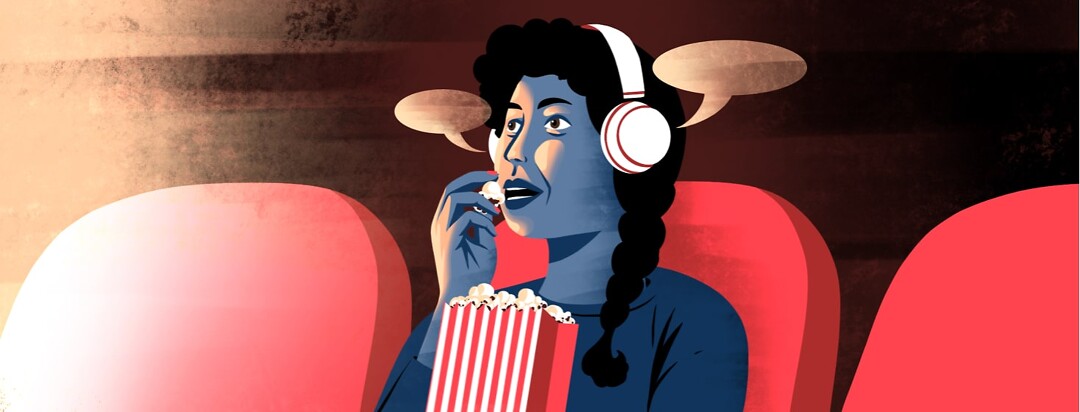Don’t Agonize – Organize: Audio Description at the Movies
Going to the movies is one outing I really enjoy (and there could be a small meal, glass of wine, cup of coffee, or piece of cake involved too). I worry that I might not be able to see the screen clearly in future years. So, instead of agonizing, I organized to see a movie with audio description and give it a trial run.
Audio descriptors
Audio description involves a narrator commenting on what is happening visually in the movie and describing scenes, gestures, facial expressions, and costumes that might not be evident to those with low vision. This happens in the spaces between the dialog in the movie.
Finding theater's accessibility features
It was difficult to find accessibility options on the theater’s website. Let me just say that if you had serious accessibility issues, you wouldn’t be able to find it at all.
I tried to find the phone number, but there wasn’t one of those either. They want you to have an online chat with a robot. Finally, I found accessibility right at the foot of the page in a very small font. Might have to talk to the robot about that later and advocate for improvement!
Evidently, audio description was available at some of the theaters, some of the time, for some of the movies.
At the theater
You can pick up a headset at the box office (well, they don’t really have box offices, they prefer you to use the touch screens in the foyer to buy tickets). Must speak to the robot about that, too! If you choose not to use the touch screens in the foyer because you have special needs (or just have a question!), you must queue up at the snack bar with people buying popcorn and ice creams.
Asking for assistance
So, I went to the theater and queued. When my turn came, I asked if my desired movie had audio description. The attendant asked if I wanted the headphones for people who couldn’t hear very well. I said that, no, I wanted the headphones for people who couldn’t see very well.
She looked quite perplexed and said that she’d have to make a phone call. Meanwhile, the people behind me were hankering for their ice creams, and I felt a bit uncomfortable holding them up, but I knew I had to be assertive here. It would have been good for everyone if I could have come a bit earlier, but they only open their box office (sorry – snack bar) 15 minutes before the first show.
Knowing where to look
Eventually, she came back and said that she was sorry, but the movie I wanted to see didn’t have audio description. She showed me the theater’s website and said I must look for this little AD sign after the movie’s name. Fair enough. That was my fault. I bought a ticket anyway and put the people waiting in the queue behind me out of their misery.
Another trip to the movies
Take two, the next day, before I left home, I found another movie on the website which did have AD next to its name. This was at a different theater complex.
I arrived at the theater, early this time, and double-checked (at the snack bar again) if my desired movie had audio description. They said that it sure did – that was for people who couldn’t hear very well, right? (Ground Hog Day!)
I said that, no, it was for people whose vision wasn’t the best. Big pause. Once again, the snack bar person searched for the supervisor. The supervisor said that if I came back in a little while, the headset would be ready for me. I suspected that the “little while” was the time needed for them to find this elusive piece of equipment.
Using audio descriptors
When I returned after my cup of coffee, my headset was there on the counter. It was a quite small box, with a set of earphones. I was shown where the volume dial was and told that channel 2 was the desired setting. The supervisor said that he had tested it - it worked, and the batteries weren’t flat (another indication that not many people had requested this service).
Are audio descriptors distracting?
I went into the movie theater, put the headphones on, and adjusted the dials as directed. No one seemed to notice or care that I was wearing them. The movie started, and I was very pleasantly surprised. The normal dialogue of the movie came through my headphones perfectly clearly.
It was only when there was a sizeable gap in the dialogue that the narrator described (through the same headphones) what was happening on screen. He spoke in a calm, smooth voice and only mentioned what a person with low vision may have missed. He described meaningful movements and facial expressions, which would help the viewer interpret what was happening. He might say something like, “The clouds looked stormy” or “A tear ran down her cheek” or “They all smiled.” He never talked over the dialogue, and what he said was kept to a minimum, so it wasn’t intrusive.
I actually enjoyed listening to the description and left the headset on for the full movie.
A brilliant solution
Obviously, there are many different narrators for different movies, but my verdict on this particular experience is: brilliant! A person with low vision wouldn’t miss any of the subtle visual cues that help us to understand the movie. If I need this assistance in the future, I won't hesitate to use it. In fact, I might even use it again soon, just so the snack bar attendants can learn where to find the headsets amongst the popcorn and ice cream.

Join the conversation